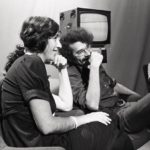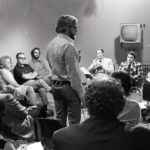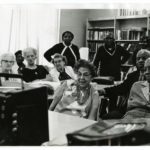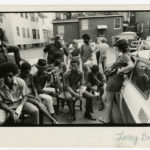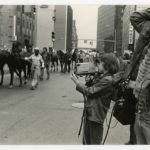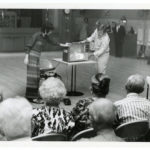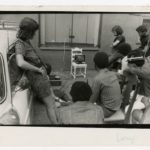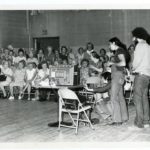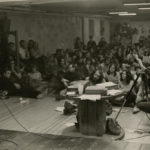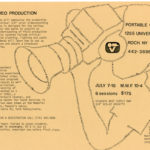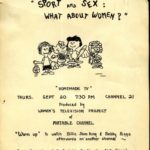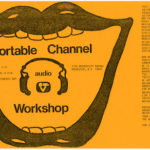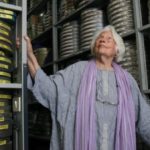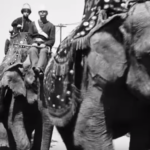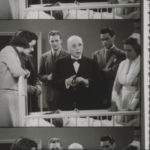Digitizing the First Days of Public Access Television
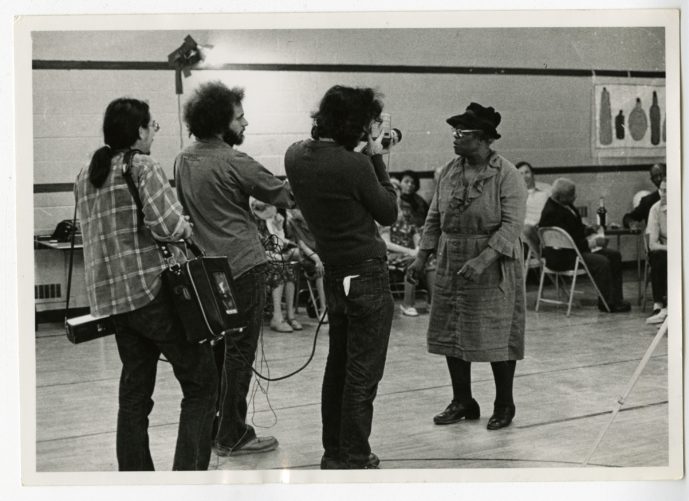
Public access to free-to-air and cable television, as to community radio, didn’t just happen. It took a lot of activism by pioneers in the face of much opposition and many technical hurdles.
The pioneers included the members of a plucky collective in New York state, Portable Channel. It began operations in 1971 and created some of the earliest citizen-made documentary television in the United States.
To draw attention to Portable Channel’s role in bringing non-corporate voices and perspectives to public view, a likeminded organisation, Visual Studies Workshop, based in Rochester, NY, is digitizing hundreds of video tapes created by members of Portable Channel and in some cases depicting their activities.
“The tapes are not moldy for the most part, which is instant death to tape, but they are in urgent need of digitization,” says Tara Nelson, the Curator of Moving Image Collections at the Visual Studies Workshop. She says digitizing the content is all the more urgent given that the sort of public-access media participation they represent now seems to be on its last legs.
Since 2017 the Workshop has received five preservation grants from the Bay Area Video Coalition that have made possible the digitization of more than 100 tapes. Now the Workshop is digitizing 200 more tapes with a Recordings at Risk grant. The Council on Library and Information Resources (CLIR) makes those grants each year with funding from The Andrew W. Mellon Foundation.
The Visual Studies Workshop began its activities in 1969. Its founder, Nathan Lyons, viewed photography as a tool of social commentary and media experimentation. The Workshop, which established a master’s degree in fine art and a press, still embraces a mission of supporting independent makers and interpreters of images through education, publications, exhibitions, and collections.
Portable Channel was a collective of media-access pioneers that began as a film-equipment pool with funding from the New York State Council on the Arts. Its founder, Bonnie Sherr Klein, wanted to provide equipment to film makers who would document grass roots community organizing and alternative reporting, and also to teach non-specialists how to use the equipment. “That was part of their original plan, and they never faltered from it,” says Nelson. “They were founded to help provide community access to production tools, to help people make their own media.”
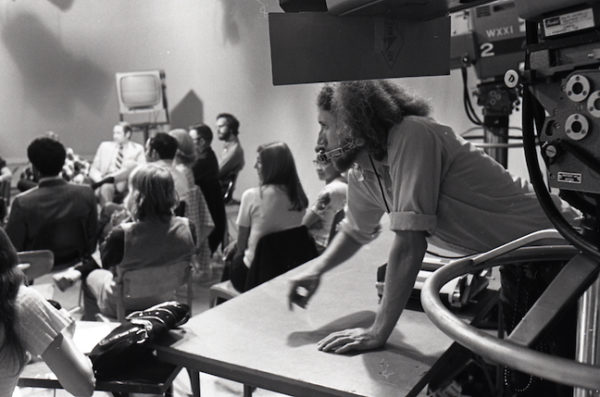
Portable Channel’s Homemade TV ran from 1972 to 1975 on WXXI-TV in Rochester.
The Portable Channel tape collection that the Workshop is gradually digitizing consists of 910 videotapes in various formats; the majority of the material is half-inch open reel with some three-quarter-inch tapes and a few 1-inch and Betamax. The Workshop’s preservation project is titled Towards a Democratic Medium: Video Activism and Community Television in the 1970’s – Preserving the Portable Channel Tapes. That reflects the way Portable Channel’s material was used. Thanks to Bonnie Klein’s vision and drive as a documentary filmmaker and activist, many Portable Channel programs emphasizing community activism and documentary work were publicly broadcast, at first via Homemade TV, which ran from 1972 to 1975 on WXXI-TV in Rochester.
In its application to the Council on Library and Information Resources, as earlier to the Bay Area Video Coalition, the Visual Studies Workshop has made the case that the collection not only is of inherent historical interest as early examples of public-access media, but can inform such fields of study as media studies, visual studies, communications, women’s studies, cultural studies, and American studies and history.
Likeminded organizations
Throughout its history, Portable Channel, which ceased operations in 1987, was closely allied to the Visual Studies Workshop, which had started up a couple of years earlier, in 1969. Nelson explains: “Rochester is not that big, and Visual Studies Workshop was centrally located and was supportive of alternative media, and still is. At the time we started, video made by untrained community people was very alternative, and it was also cumbersome. We were one of the only places video makers could show their work, or meet, or have a workshop, so we often loaned space or supported events.
“Portable Channel had a few locations in the early days but eventually settled on the same block as us. We also had a media center that loaned equipment. So a lot of members of Visual Studies Workshop were also members of Portable Channel.”
The key feature of what those pioneers produced, she says, was social activism and diversity. “The producers were independent people with their own proclivities and interests, and they were very rooted in political causes. There was a core group of about 12 producers who were working in all types of community activism and progressive politics. So, subject matter wise, there is a lot of political activity, such as documenting war protests. There’s footage of Shirley Chisholm, the first black woman to run for President. They covered alternative news that wouldn’t have been covered in the mainstream media.”
One producer who is still active was Sanford (“Sandy”) Rockowitz, several of whose productions are among the reels being digitized, now. Much of his work from that era relates to the Attica Prison uprising of 1971. Rockowitz covered many aspects of the rebellion. He interviewed trial lawyers along with prisoners involved. He created programs about police brutality.
{Click on an image to expand}
Scenes from activities of Portable Channel
Rockowitz also made programs about eldercare homes, a timely subject of concern then, as now. Other Portable Channel material related to the burgeoning women’s movement. Among the collection, as a result, is content relating to women in the workplace and society and the portrayal of women in the media.
A range of Portable Channel output is already on the Workshop’s website. Nelson says: “When we first got a Bay Area Video Coalition grant, we tried to get as much of a survey of what Portable Channel was covering as we could.” Illustrating broad topics such as women’s right are films focusing on specific topics of local interest — for example, the issue of women’s rights in Rochester is illustrated by one film about the role of women in Catholic ministry in the city during the early 1970s.
Also in the collection are items relating to innovative art practitioners such as the San Francisco Mime Troupe and artists from Western New York, a hotbed of arts experimentalism at the time — avant-garde composition, multimedia works, and the like — thanks to support from the New York State Council for the Arts.
Bonnie Klein
The contributions of Bonnie Klein are of particular significance in the history of alternative reporting and advocacy in the United States. Klein — who resides in Vancouver, Canada, and is the mother of activist author Naomi Klein — is still active in social causes, particularly around disability after a stroke in 1987.
At the beginning of her career, she was a student of George Stoney, who is often called “the father of public-access television.” Klein worked with him on early productions in Canada in the late ’60s and early ’70s, when video was emerging.
Stoney’s approach was to document social causes and conditions from an amateur perspective — his was a sort of updated grassroots cinema verité. While Stoney worked with film, Klein reasoned that his approach could be advanced through the use of video cameras, which were just emerging as a consumer product.
In one of her early pieces, VTR San Jacques, from 1969, she helped a citizens’ committee in a neighborhood of Montreal to use videotape recording and closed-circuit television recordings to help identify and solve community challenges.
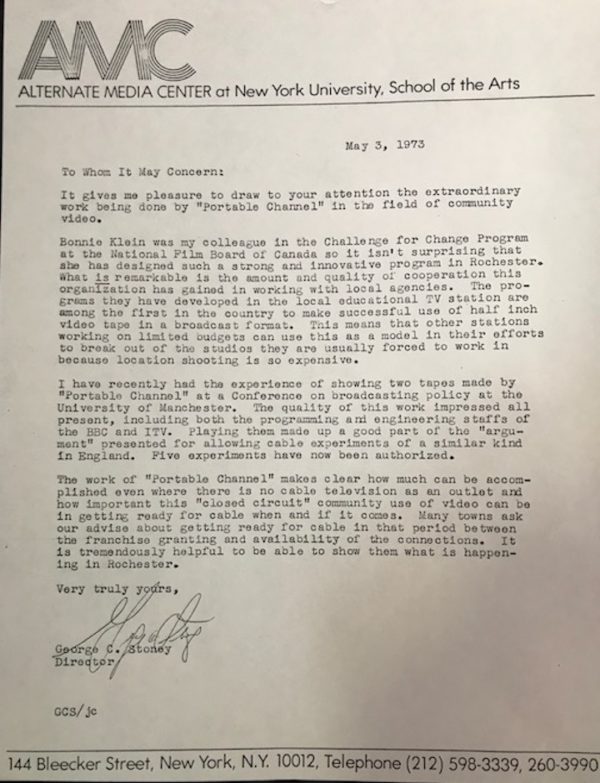 Klein saw, says the VSW’s Tara Nelson, that video cameras provided an easier approach to sound recording than 16mm cameras. Video was so new a format that colleagues like George C. Stoney had grounds for being skeptical of its use. But Stoney nonetheless sang Klein’s praises for her innovations with the medium. In a 1973 letter (left) in support of Klein’s application for a grant, Stoney, then director of the Alternate Media Center at New York University, noted that she had demonstrated to educational television stations how they could affordably undertake location shooting in their local communities.
Klein saw, says the VSW’s Tara Nelson, that video cameras provided an easier approach to sound recording than 16mm cameras. Video was so new a format that colleagues like George C. Stoney had grounds for being skeptical of its use. But Stoney nonetheless sang Klein’s praises for her innovations with the medium. In a 1973 letter (left) in support of Klein’s application for a grant, Stoney, then director of the Alternate Media Center at New York University, noted that she had demonstrated to educational television stations how they could affordably undertake location shooting in their local communities.
He drew particular attention to how suited the medium was in helping nonprofit stations and organizations make their case for access to cable television, if and when it arrived.
Nelson says that Klein’s proof of that concept included establishing the relationship with WXXI, enabling Portable Channel to broadcast its programs. Their method for doing that was “very much an experiment,” Nelson says. Klein and her colleagues brought a playback device and monitor to the TV station, and there camera operators zoomed in on the monitor.
Stoney and Klein’s approaches and philosophy of public access “became very important when legislation was passed to mandate that cable companies provide access to independent producers,” Nelson says. In his letter, Stoney describes how Klein demonstrated video’s role in that media revolution, and that makes his letter “a huge missing link” in the history of public access, Nelson says. She adds that she expects that the Portable Channel material that Visual Studies Workshop is now having digitized will include footage of community meetings where pioneers like Klein and Rockowitz figured out what cable television would be able to be, and be able to do for community activism — discussions about “how do we make sure that people can maintain access to and develop and grow access to media and make sure it’s representing us faithfully.”
The Visual Studies Workshop inherited the Portable Channel’s collection in 1987, when Portable Channel closed down. After a sharp drop-off in federal and state funding for the arts, it had briefly but unsuccessfully sought to run as a commercial enterprise. “They knew we had several thousand square feet of space in our buildings, and that we were a regional archive, so we arranged to take on the collection,” says Nelson, who oversees VSW’s collection of more than 5,000 16mm films and 4,000 magnetic media titles.
{Click on an image to expand}
The Visual Studies Workshop also inherited remaining Portable Channel equipment, which has proven invaluable for playback and for preservation work, Nelson says. “A lot of the original cameras don’t work, but the playback does, so we are able to play back the half inch and digitize reels, ourselves, to some degree. We have an in-house conversion lab, but we won’t be using that, for this CLIR grant.” That work is being done by The Standby Program, which is based in the New York city area.
The material will also go up on the Workshop’s website. “I think,” says Nelson, “that this collection is just the pulsing core of community access, cable access, media access.” Capturing it and the story it tells is all the more important, now that the cable-access era is “almost at its last breath,” she believes. “We need to know what that story is and get the story straight.”
— Peter Monaghan
Previous Post: A Home Movie Day Unlike the Others
Next Post: The Total Television Guerrillas Who Upturned Conventions

